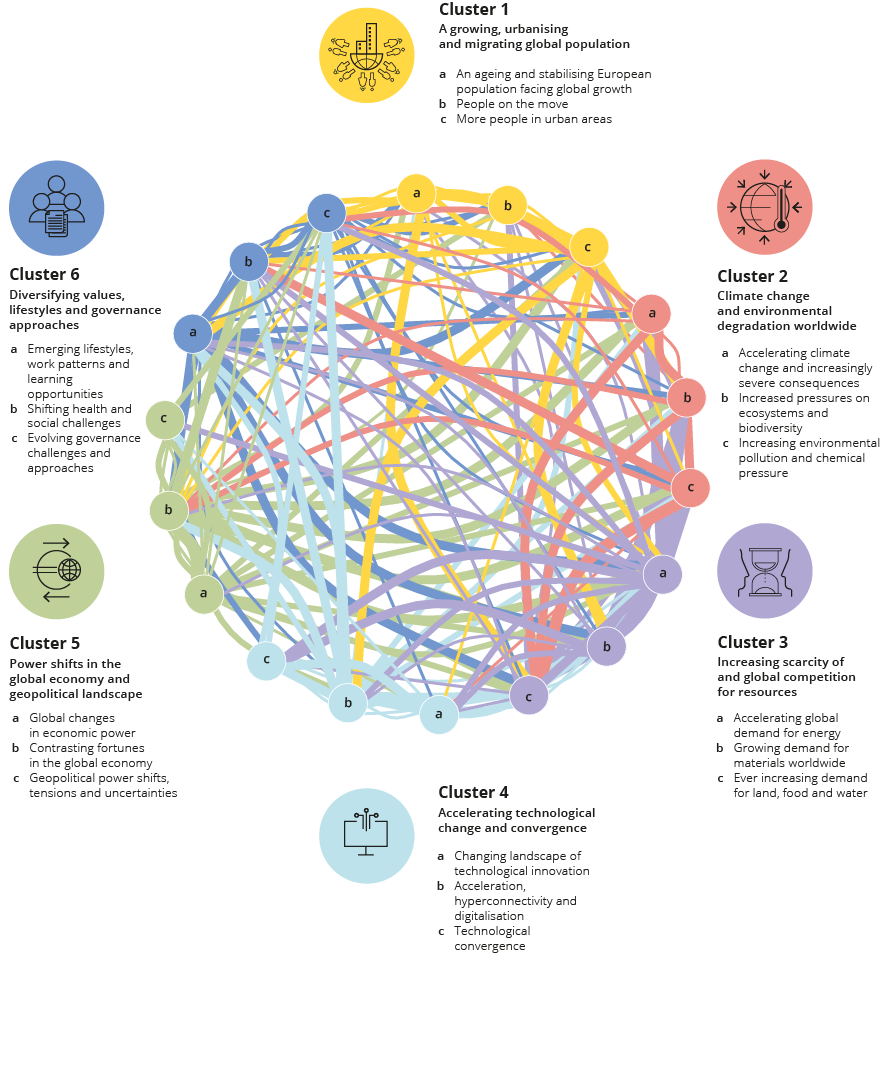Many 'drivers of change' that impact the environment and sustainability in Europe are actually not of an environmental nature and of European origin, but they are crucially important in determining Europe's long-term environmental and sustainability outlook. As a result, there has been growing interest in systems thinking and anticipatory knowledge within EU institutions in view of designing better-informed and ultimately more effective policies.
There has been growing interest in systems thinking and anticipatory knowledge within EU institutions in view of designing better-informed and ultimately more effective policies.
The future of Europe's environment and sustainability is likely to be highly influenced by developments of societal, technological, economic, environmental and geopolitical natures, as well as changes in values and lifestyles. These 'drivers of change' differ from each other in relation to their origin, nature, likelihood, significance, geographical scale and timescale. Although some of them are well established and well known, some have just emerged, and their effects have not yet unfolded or are still unknown.
Background information: The four categories of ‘drivers of change’
- Global megatrends are global, long‑term trends that are slow to form but have a major impact once in place. They are the great forces that are likely to affect the future in all areas throughout the world over the next 10 to 15 years. Furthermore, they are often strongly interconnected.
- European trends are mid to long-term trends specific to Europe and, contrary to global megatrends, not all of them are likely to have major implications at global scale. They are directly or indirectly interconnected between them and with global megatrends. Their direction of change can be aligned or contrasting to global megatrends (e.g. a stagnating European population in contrast to a growing global population).
- Emerging trends represent emerging developments that are occurring at a fast pace but are not yet fully established over mid to long-term timescales, and for this reason their potential implications are not yet well understood. Depending on their evolution, they might lead to the establishment of new European trends or global megatrends.
- Wild cards, instead, are developments that may seem unlikely or very unlikely at present but could occur in the future, and, if they do, they are likely to bring about disruptive changes.
Clusters of drivers of change
In order to explore even further the characteristics, interactions and potential implications of the ‘drivers of change’, the EEA has developed and identified six thematic clusters using the STEEPV framework (i.e. society, technology, economy, environment, politics and values):
- Cluster 1 — Growing, urbanising and migrating global population.
- Cluster 2 — Climate change and environmental degradation worldwide.
- Cluster 3 — Increasing scarcity of and global competition for resources.
- Cluster 4 — Accelerating technological change and convergence.
- Cluster 5 — Power shifts in the global economy and geopolitical landscape.
- Cluster 6 — Diversifying values, lifestyles and governance approaches.
Thematic clusters and their interactions
Note: The width of the connectors illustrates a qualitative estimation of the strength of the interaction among drivers of change.
What does this mean for Europe?
- The global/European socio-economic and political context is changing rapidly and has potential implications for the ability of Europe to meet its environmental and sustainability goals.
- At the global scale, sustainability challenges like poverty, inequality, food security, and access to healthcare and education are still an issue for a large part of the global population, although the world population is ageing and reducing its growth as a result of improved average living conditions.
- In the last decades, Europe had to face unexpected developments such as multiple financial crises, growing immigration pressure, terrorism, the rise of populism and societal polarisation, the growing influence of social-media, fake news, the rise of a multipolar world and the erosion of the established international order (e.g. trade wars, regional conflicts).
- Many global and European developments in recent decades (e.g. rise of a global middle class, growing demand for resources, growing economic activity) increase the likelihood of a continuation of 'Great Acceleration' megatrends (Steffen et al., 2011, 2015) and consequent impacts on the environment, on climate, as well as ecosystems and biodiversity.
- Other drivers of change such as technological and social innovations, however, are less certain in their implications for the environment and sustainability, as the interactions between multiple factors (including values, lifestyles, governance) bring additional layers of complexity and uncertainty regarding their outcomes.
- The European institutions, its citizens, as well as a variety of actors across society can reposition themselves in front of the upcoming environmental and sustainability challenges and chase the opportunities that lie ahead. While the European Green Deal has the potential to act as lever, there are lock-ins and barriers deeply entrenched in our way of producing and consuming, for which fundamental change would be necessary.
Find out more on:
Emerging trends
What could be the implications of specific societal, technological, economic and geopolitical developments on the environment and sustainability? The result of a horizon-scanning process run by EEA and Eionet experts shed light on:
Narratives for change
Incremental change is no longer an option, particularly for achieving long-term goals, and more fundamental changes in lifestyles and patterns of consumption and production are likely to be necessary to achieve sustainability goals. Such fundamental transformations call for reflections on the principles, paradigms and narratives that shape our collective and individual action. The following narratives bring new perspectives to the fore, to support reflections and trigger change:
Cover photo: © Perry Wunderlich, REDISCOVER Nature /EEA

Document Actions
Share with others